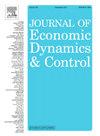Regime-specific exchange rate predictability
IF 2.3
3区 经济学
Q2 ECONOMICS
引用次数: 0
Abstract
We study temporary phases of exchange rate predictability in a two-regime threshold predictive regression framework allowing for persistent predictors. Regime switches are triggered by an observable transition variable which relates to media news, expectations, uncertainty and global financial conditions. As predictors for G7 currencies and effective US-Dollar exchange rates, we study various interest rate spreads, yield curve factors, uncertainty measures and deviations from fundamental exchange rate parities. Besides established uncertainty measures, we use a wide range of measures for media coverage and construct uncertainty measures from survey data as transition variables for the activation of the predictability regime. Our results emphasize that short recurring phases of significant predictability are characterized by nonlinear patterns. Phases of predictability are triggered by increased media coverage and high uncertainty with interest rate dynamics emerging as the most important predictor. We find broadly similar results for a contemporaneous threshold analysis where our regressors are allowed to affect the exchange rate in the same period. From a theoretical point of view, we argue that our empirical results are useful for the empirical identification of scapegoat effects and that media coverage and uncertainty affect the exchange rate via the heterogeneity of private signals and the precision of public signals.
特定制度的汇率可预测性
我们研究汇率可预测性的临时阶段,在一个允许持久预测的双制度阈值预测回归框架。制度转换是由一个可观察到的过渡变量触发的,该变量与媒体新闻、预期、不确定性和全球金融状况有关。作为G7货币和美元有效汇率的预测者,我们研究了各种利差、收益率曲线因素、不确定性措施以及与基本汇率平价的偏差。除了建立的不确定性度量,我们使用了广泛的媒体报道度量,并从调查数据中构建不确定性度量,作为激活可预测性制度的过渡变量。我们的研究结果强调,具有显著可预测性的短期重复阶段具有非线性模式的特征。可预测性阶段是由媒体报道的增加和高度不确定性引发的,利率动态成为最重要的预测因素。在允许回归量影响同一时期汇率的同期阈值分析中,我们发现了大致相似的结果。从理论的角度来看,我们认为我们的实证结果对替罪羊效应的实证识别是有用的,媒体报道和不确定性通过私人信号的异质性和公共信号的精度影响汇率。
本文章由计算机程序翻译,如有差异,请以英文原文为准。
求助全文
约1分钟内获得全文
求助全文
来源期刊

Journal of Economic Dynamics & Control
ECONOMICS-
CiteScore
3.10
自引率
10.50%
发文量
199
期刊介绍:
The journal provides an outlet for publication of research concerning all theoretical and empirical aspects of economic dynamics and control as well as the development and use of computational methods in economics and finance. Contributions regarding computational methods may include, but are not restricted to, artificial intelligence, databases, decision support systems, genetic algorithms, modelling languages, neural networks, numerical algorithms for optimization, control and equilibria, parallel computing and qualitative reasoning.
 求助内容:
求助内容: 应助结果提醒方式:
应助结果提醒方式:


